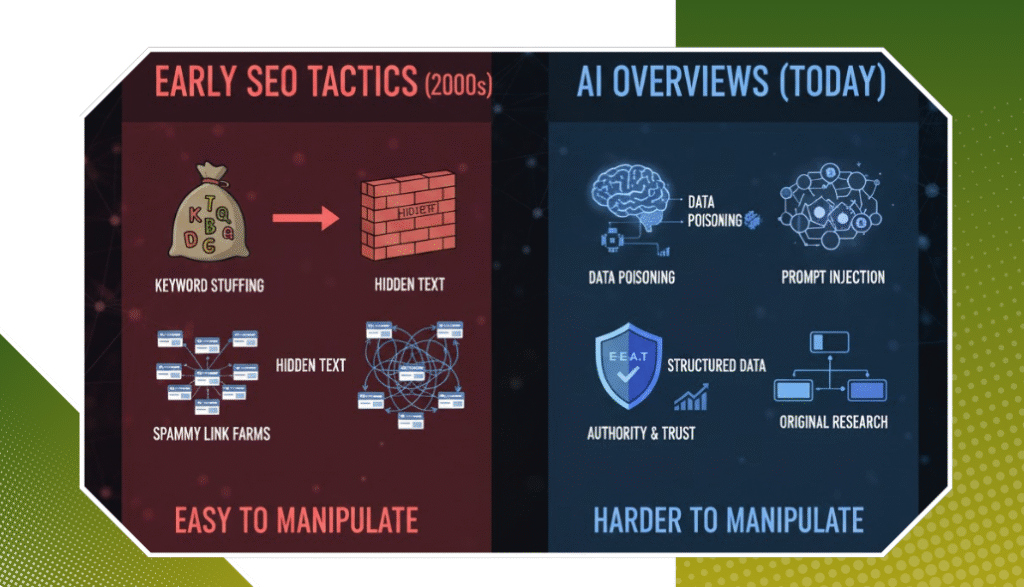What Are AI Overviews?
AI Overviews are AI-generated summaries displayed at the top of Google’s search results. Instead of showing a single excerpt from one webpage, Google uses its large language model (LLM), Gemini, to generate a synthesized answer based on multiple high-authority sources. These AI Overviews aim to answer user queries directly and efficiently without requiring a click-through.
The technology behind AI Overviews includes generative AI models, natural language understanding, and semantic search capabilities. Rather than simply matching keywords, these models interpret user intent and gather relevant data points to build a coherent response.
For example, a traditional snippet for the query “What is quantum computing?” might quote one website. In contrast, an AI Overview could combine information from MIT, IBM, and Britannica to provide a richer, multi-source explanation.
Why Is Google Making the Shift?
Google’s goal has always been to organize the world’s information and make it universally accessible and useful. As user expectations grow, so does the need for more intelligent systems that anticipate and satisfy search intent instantly. Here are some key reasons for the transition:
- Improved Search Efficiency: AI Overviews reduce the time users spend sifting through different links. According to Google’s internal testing, users complete tasks faster when presented with AI-generated summaries, especially for complex or research-heavy queries.
- Enhanced Accuracy: Unlike a single-source snippet, AI Overviews pull from multiple reputable sources. This can reduce bias, provide more balanced information, and enhance the trustworthiness of the content.
- Better User Experience on Mobile and Voice: With the rise in mobile and voice search, users prefer concise answers. AI Overviews align well with this trend by delivering content that’s short, contextually rich, and easily digestible.
Impact on Search Behavior
The rise of AI Overviews has already begun to influence how users interact with search results:
- Increase in Zero-Click Searches: AI Overviews often provide complete answers, leaving users with no need to click further. This trend is not new, but AI Overviews are accelerating it significantly. According to Similarweb (2023), over 57% of Google searches end without a click. AI-generated answers will likely push that number even higher.
- Higher Expectations for Relevance and Speed: Users now expect Google to answer complex questions in seconds. This places more pressure on Google’s AI systems to maintain high accuracy and contextual depth in its responses.
- Skepticism and Trust Factors: While many appreciate the convenience, some users remain skeptical of the accuracy of AI-generated content. Google addresses this by offering clickable sources in each AI Overview, but the challenge of maintaining user trust remains.
What Does This Mean for Content Creators and SEOs?
With traditional snippets being phased out, digital marketers and SEO professionals must rethink their strategies:
Content Structure Matters More Than Ever
To be featured in or contribute to an AI Overview, content must be well-structured, clearly written, and backed by reputable sources. Google’s systems prioritize clarity, factual accuracy, and logical flow.
Snippets in SEO Still Have a Role
Even though AI Overviews are taking over, snippets in SEO, particularly those marked up with schema, remain valuable. Structured data helps Google interpret content and extract relevant information, making it more likely to be referenced in AI-generated content.
Featured Snippets vs AI Overviews
Google featured snippets still appear in some queries, especially those with clear-cut answers. However, their role is becoming more limited. Unlike featured snippets, AI Overviews are designed to handle multi-faceted or nuanced queries.
Content that previously ranked in featured snippets may now be part of a broader AI-generated response. Therefore, targeting long-tail keywords, writing in-depth content, and using subheadings (H2s and H3s) can improve visibility.
Authoritativeness and Topical Depth
Google’s AI models favor websites that demonstrate expertise and trustworthiness. This means publishing consistently high-quality, original content on specific topics is essential. Sites that have authority in a niche are more likely to have their content referenced in Google AI Overview sections.
Criticism and Concerns
While the benefits of AI Overviews are clear, the shift isn’t without controversy:
- Potential for Misinformation: Generative AI systems, including Google’s, have been criticized for “hallucinating” facts, creating plausible but incorrect information. While Google claims to mitigate this by citing sources, errors can still occur.
- Content Attribution Issues: Some publishers argue that AI Overviews reduce traffic to their sites, even though their content is used to generate the summaries. This raises concerns around fair attribution and monetization.
- Dependence on AI Interpretation: AI models interpret context, but they can sometimes misread nuance or cultural significance. This can be problematic, especially for sensitive topics or localized queries.
How to Adapt Your SEO Strategy?
As AI Overviews become more common, here are key ways to optimize your content:
- Focus on Topical Authority: Establish yourself as a trusted authority in your niche. Publish detailed, evergreen content that covers a topic from multiple angles.
- Use Clear Formatting and Schema: Use H2s, bullet points, tables, and FAQs to structure your content. Implement structured data to help Google parse and organize your content.
- Refresh and Update Content Regularly: AI systems value up-to-date information. Keep content fresh with the latest data, facts, and research to increase its likelihood of being referenced.
- Answer Questions Directly: Write concise, informative answers to common questions. These could be pulled into both featured snippets and AI Overviews.
- Monitor AI Overview Trends: Use tools like Google Search Console and third-party platforms to analyze how your content is being used in AI-generated summaries. Adapt content accordingly.
Conclusion
Google’s move from traditional snippets to AI Overviews represents a significant evolution in search. By leveraging generative AI, Google aims to provide users with faster, deeper, and more contextual answers right on the results page. For content creators and SEOs, this shift underscores the need for authoritative, clearly structured, and well-optimized content. While AI Overviews may reduce clicks, they also offer new ways to reach and engage users if you adapt strategically.




